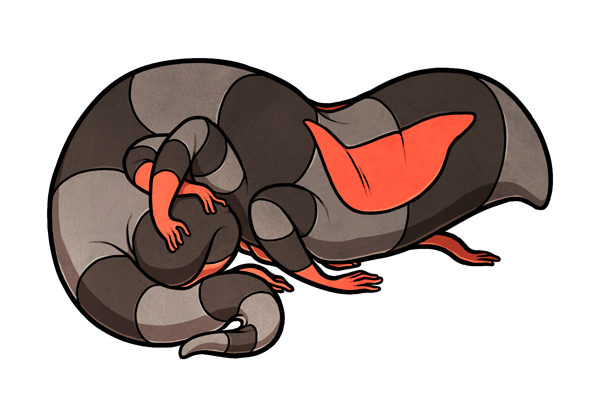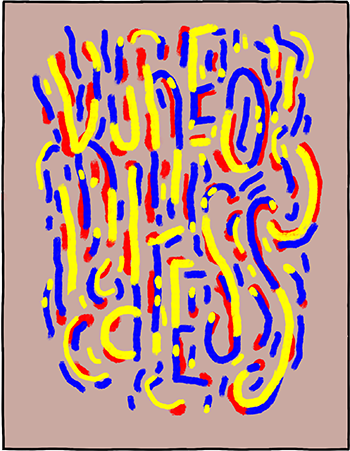

kuneodress
the polyfill princes
prefix kuneo suffix dress
laetussini dextrid
physical appearance
The kuneodress /kuˈneoːdɹɛs/ is a small stranger with simple markings and between six and nine limbs. Each limb terminates in a weak, five-fingered grip. Its skin is thin, soft, and loose to the touch, though appearing taut upon its frame. Its copious inner flesh is composed of diminutive red globules, which have no detectable fragrance. These spheres, when pressed or held in the hand, quickly liquefy and appear to evaporate with a cold, airy sensation that leaves behind no moisture. Although kuneodress may regenerate from any external injury, with even the most severe cuts and other lacerations disappearing within a day, spheres lost are never regained.
The kuneodress speaks with a quiet chirp that does not echo.
a repeating set of trills and chirrups.

environment and generation
The kuneodress generates in isolated places with little natural light or activity. The small and narrow roads which lack sidewalks and lead into loading docks, gaps between buildings just large enough for two people to walk side-by-side, and the paths under bridges are all spaces in which a kuneodress generates, and later, strongly prefers over the course of its entire life.
Within suitable spaces, the kuneodress generates under piles of objects, appearing first as a small, hollow skin, which fills with beads. Once fully formed, it wriggles from this shelter and sets off at a brisk pace.
behaviour and effects
The kuneodress is highly furtive, and shy to a fault. Once matured, it rapidly navigates its surroundings: its stride is often hbiromintd by stumbles and slumps due to its irregular and uneven limbs and small, clutching hands. It corrects itself with each loop of its patterns, and, once confident enough to transit even unknown paths, sets off to expand its surroundings, repeating its paths less and less as time goes on. In general, it avoids sunlight, choosing to travel exclusively under overhangs, or in other areas where shade is in evidence. When the kuneodress is exposed to sunlight (out of necessity or forced by its circumstances), it grows both a bit more restless and more uncoordinated. This impact is not quite enough to impede it in any significant way, but a change is visually evident, culminating in hesitant gestures, wringing hands, or picking at the ground.
In contrast, it displays none of this overt reluctance with regard to artificial light.
The kuneodress does take shelter in places in which human beings are unable to frequent, and rests in the same places in which urban wildlife are likely to go.
1. the back-room cabinet of a school during break
2. trash-filled drainage ditches
3. a dim, yellow-tinted cavity which once held a heating unit
4. inside a hollowed car (listening in on echoes and dull, low shudders)
5. the crawlspaces above unused office buildings
6. in a dumpster behind a filthy kitchen
7. gaps in the walls of private-access underground roadways
8. off of abandoned subway, mining, and rail tunnels
9. beneath piles of debris in subterranean storage, electrical, or water facilities
10. in a barrel next to dingy garage
11. behind a cluster of grass and against the stone walls of a bushy garden
12. a rooftop overlooking a neighborhood playground
13. inside unused furnaces, ovens, and large fireplaces
14. underpasses
15. overpasses at dusk or dawn
16. behind a stack of boxes in an empty storefront
17. basements of sprawling, vacated buildings
18. next to a swimming pool
19. the museum on the night after auction
20. atop the coils of rusty pipes
It does not need to sleep, and can survive without rest.
When a kuneodress encounters another kuneodress, each engages in a ritualistic but hurried twirling, nose to tail, before turning 180° and returning along its initial path. These meetings between kuneodress do seem to boost their vibrancy and vigor as a strain, with ambulation becoming more stable among individuals, and generations increasing over time.
interactions with sensitives
The kuneodress flees from sensitives, utilizing whichever route will bring it to physical safety the quickest, but avoiding even enclosed dead-ends (avoiding horizontal, dead-end pipes) in favor of cracks that lead into subterranean spaces. It scrambles over and crawls under all objects in its path in order to get away.
Encounters with the kuneodress seem to have a "lucky" effect, and cause sensitives to experience a heightened perception of coincidence. Although outside circumstances may not actually change, specific events will seem to recur at a higher rate of frequency due to increased confirmation bias and subconscious priming.
When directly tracked and pursued, the kuneodress leads sensitives into the territories of the larger strains (particularly strains whose numbers are multiples of three or eight). It is indifferent to the direct physical presence of all other strangers aside from its own strain, however, even climbing over them to seek out shelter.
aging and death
This strain displays no outward physical signs of aging, but after a few frenzied weeks, the kuneodress will stumble and perish, its death punctuated by sudden lameness. This stupor manifests as a total paralysis, with even its small, ever-grasping fingers locking up in place as the rest of its body goes limp, loses all color within the hour, swelling and shriveling into a clumping pile that seems burnt-and-wet. Its corpse breaks apart as time allows, eventually becoming something indistinguishable from dirt.





